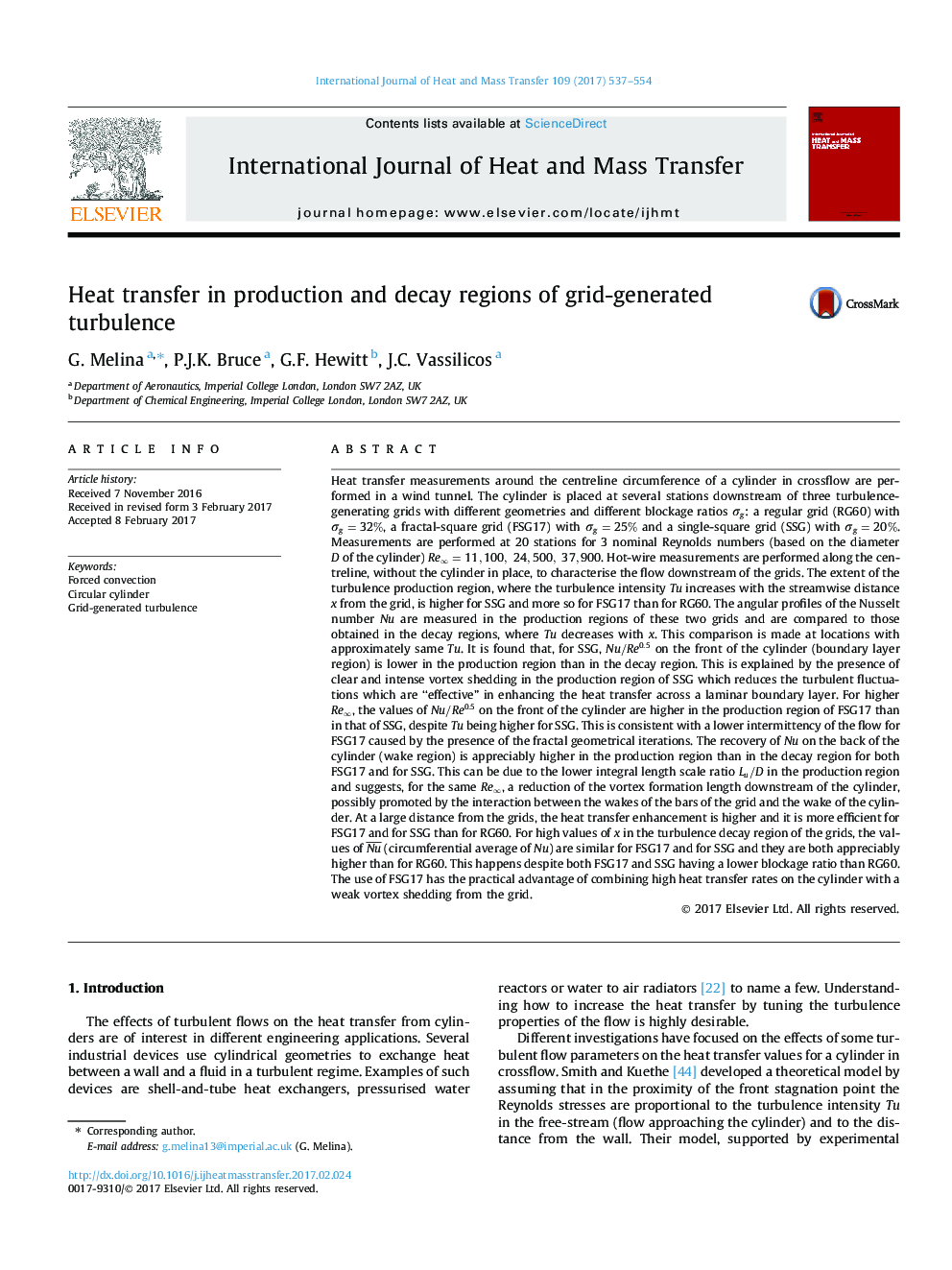| کد مقاله | کد نشریه | سال انتشار | مقاله انگلیسی | نسخه تمام متن |
|---|---|---|---|---|
| 4994508 | 1458032 | 2017 | 18 صفحه PDF | دانلود رایگان |
عنوان انگلیسی مقاله ISI
Heat transfer in production and decay regions of grid-generated turbulence
ترجمه فارسی عنوان
انتقال حرارت در مناطق تولید و ناپدید شدن آشفتگی تولید شده در شبکه
دانلود مقاله + سفارش ترجمه
دانلود مقاله ISI انگلیسی
رایگان برای ایرانیان
کلمات کلیدی
کنسانتره اجباری، سیلندر دایره ای آشفتگی ایجاد شده شبکه
موضوعات مرتبط
مهندسی و علوم پایه
مهندسی شیمی
جریان سیال و فرایندهای انتقال
چکیده انگلیسی
Heat transfer measurements around the centreline circumference of a cylinder in crossflow are performed in a wind tunnel. The cylinder is placed at several stations downstream of three turbulence-generating grids with different geometries and different blockage ratios Ïg: a regular grid (RG60) with Ïg=32%, a fractal-square grid (FSG17) with Ïg=25% and a single-square grid (SSG) with Ïg=20%. Measurements are performed at 20 stations for 3 nominal Reynolds numbers (based on the diameter D of the cylinder) Reâ=11,100,24,500,37,900. Hot-wire measurements are performed along the centreline, without the cylinder in place, to characterise the flow downstream of the grids. The extent of the turbulence production region, where the turbulence intensity Tu increases with the streamwise distance x from the grid, is higher for SSG and more so for FSG17 than for RG60. The angular profiles of the Nusselt number Nu are measured in the production regions of these two grids and are compared to those obtained in the decay regions, where Tu decreases with x. This comparison is made at locations with approximately same Tu. It is found that, for SSG, Nu/Re0.5 on the front of the cylinder (boundary layer region) is lower in the production region than in the decay region. This is explained by the presence of clear and intense vortex shedding in the production region of SSG which reduces the turbulent fluctuations which are “effective” in enhancing the heat transfer across a laminar boundary layer. For higher Reâ, the values of Nu/Re0.5 on the front of the cylinder are higher in the production region of FSG17 than in that of SSG, despite Tu being higher for SSG. This is consistent with a lower intermittency of the flow for FSG17 caused by the presence of the fractal geometrical iterations. The recovery of Nu on the back of the cylinder (wake region) is appreciably higher in the production region than in the decay region for both FSG17 and for SSG. This can be due to the lower integral length scale ratio Lu/D in the production region and suggests, for the same Reâ, a reduction of the vortex formation length downstream of the cylinder, possibly promoted by the interaction between the wakes of the bars of the grid and the wake of the cylinder. At a large distance from the grids, the heat transfer enhancement is higher and it is more efficient for FSG17 and for SSG than for RG60. For high values of x in the turbulence decay region of the grids, the values of Nuâ¾ (circumferential average of Nu) are similar for FSG17 and for SSG and they are both appreciably higher than for RG60. This happens despite both FSG17 and SSG having a lower blockage ratio than RG60. The use of FSG17 has the practical advantage of combining high heat transfer rates on the cylinder with a weak vortex shedding from the grid.
ناشر
Database: Elsevier - ScienceDirect (ساینس دایرکت)
Journal: International Journal of Heat and Mass Transfer - Volume 109, June 2017, Pages 537-554
Journal: International Journal of Heat and Mass Transfer - Volume 109, June 2017, Pages 537-554
نویسندگان
G. Melina, P.J.K. Bruce, G.F. Hewitt, J.C. Vassilicos,
